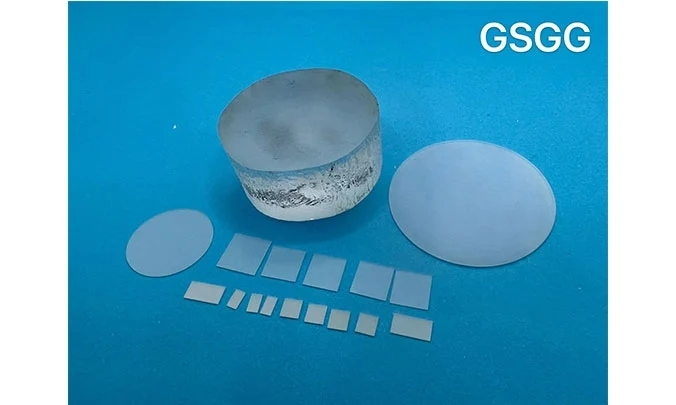GSGG, standing for Gadolinium Scandium Gallium Garnet, is a crystalline material with unique optical properties that make it valuable for various applications in photonics. This article delves into the characteristics of GSGG, exploring its crystal structure, refractive index, compatibility with other materials, and potential uses in the field of photonics.
GSGG belongs to the class of materials known as garnets. These materials share a common cubic crystal structure, specifically a garnet structure with a space group Ia3d. This structure consists of a unit cell with large dodecahedral (twelve-sided) sites occupied by rare earth cations (like Gadolinium in GSGG), octahedral (eight-sided) sites occupied by trivalent cations (like Scandium and Gallium in GSGG), and oxygen anions filling the remaining tetrahedral (four-sided) and octahedral sites. The specific arrangement of these ions determines the material's physical and optical properties.
Within the GSGG structure, Gadolinium (Gd) occupies the dodecahedral sites, contributing to its high density. Scandium (Sc) and Gallium (Ga) share the octahedral sites, influencing the material's refractive index and thermal properties. The specific ratios of these elements can be adjusted to tailor the material's characteristics for specific applications.

The refractive index is a crucial parameter in optics, representing a material's ability to bend light. For GSGG, the refractive index varies depending on the wavelength of light. At a commonly used wavelength of 1064 nanometers (nm), which falls within the near-infrared spectrum, GSGG exhibits a refractive index of approximately 1.94. This relatively high refractive index makes GSGG suitable for various optical components that manipulate light, such as waveguides and lasers.
GSGG shares a close structural relationship with another garnet material, Gadolinium Gallium Garnet (GGG). Due to this similarity, GGG single crystals can be used as substrates for growing thin films of various optoelectronic materials through a process called epitaxial growth. Epitaxy allows for the creation of high-quality crystalline films with specific properties tailored for specific applications.
Some of the prominent optoelectronic materials that can be grown epitaxially on GGG substrates include:
Gadolinium Gadolinium Oxide (Gd2O3): This material serves as a host for rare-earth dopants, leading to the creation of efficient solid-state lasers.
Yttrium Aluminum Garnet (YAG): YAG is a widely used material for solid-state lasers known for its high efficiency and tunability. Growing YAG epitaxially on GGG allows for the creation of composite structures with improved properties.
Lithium Niobate (LiNbO3): This material possesses excellent nonlinear optical properties, making it valuable for applications like frequency conversion and electro-optic modulation.
The choice of optoelectronic material for epitaxial growth depends on the desired functionality and application.
While GSGG itself can find applications in specific areas due to its unique properties like high density and refractive index, GGG, its close structural relative, has a wider range of established uses. Here are some notable application areas of GGG:
Solid-state lasers: GGG serves as a substrate for growing laser crystals such as Gd2O3 and YAG. These lasers find applications in various fields, including material processing, medical procedures, and spectroscopy.
Magneto-optic devices: GGG substrates are used for epitaxial growth of materials exhibiting the magneto-optic effect. This effect allows for the control of light polarization using magnetic fields, paving the way for optical modulators and isolators.
Waveguides: GGG's high refractive index makes it suitable for creating waveguides, which can efficiently confine and guide light signals. These waveguides are essential components in integrated optical circuits for telecommunication and sensing applications.
Substrates for other functional materials: GGG's well-defined crystal structure and thermal stability make it a versatile platform for growing various functional materials. These materials can exhibit diverse properties, ranging from superconductivity to piezoelectricity.
In conclusion, GSGG and its close relative, GGG, represent valuable materials for advanced photonics applications. Their unique crystal structure, high refractive index, and compatibility with various optoelectronic materials make them promising candidates for future developments in lasers, waveguides, and other photonic devices. As research in this field continues, we can expect to see even more innovative applications emerge utilizing the potential of GSGG and GGG.